Megachilidae
| Megachilidae | |
|---|---|
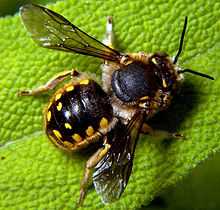 | |
| Male carder bee, Anthidium manicatum | |
| Scientific classification | |
| Kingdom: | Animalia |
| Phylum: | Arthropoda |
| Subphylum: | Hexapoda |
| Class: | Insecta |
| Order: | Hymenoptera |
| Suborder: | Apocrita |
| Superfamily: | Apoidea |
| Family: | Megachilidae |
| Subfamilies | |
|
Fideliinae | |
The Megachilidae are a cosmopolitan family of (mostly) solitary bees whose pollen-carrying structure (called a scopa) is restricted to the ventral surface of the abdomen (rather than mostly or exclusively on the hind legs as in other bee families).
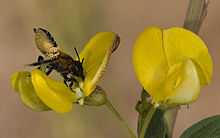
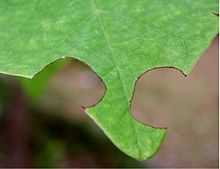
Megachilid genera are most commonly known as mason bees and leafcutter bees, reflecting the materials they build their nest cells from (soil or leaves, respectively); a few collect plant or animal hairs and fibers, and are called carder bees. All species feed on nectar and pollen, but a few are cleptoparasites (informally called "cuckoo bees"), feeding on pollen collected by other megachilid bees. Parasitic species do not possess scopae. The brightly colored scopa leads to a colloquial name used occasionally in North America - "jelly-belly bees".[citation needed] Megachilid bees are among the world's most efficient pollinators because of their energetic swimming-like motion in the reproductive structures of flowers, which moves pollen, as needed for pollination. One of the reasons they are efficient pollinators is their frequency of visits to plants, but this is because they are extremely inefficient at gathering pollen; compared to all other bee families, megachilids require on average nearly 10 times as many trips to flowers to gather sufficient resources to provision a single brood cell.
North America has many native megachilid species, but alfalfa leafcutter bees (Megachile rotundata) are an imported species used for pollination. The most significant native species is Osmia lignaria (the orchard mason bee or blue orchard bee), which is sold commercially for use in orchard crop pollination, and which can be attracted to nest in wooden blocks with holes drilled in them (which are also sold commercially for this purpose).
Life cycle
Nonparasitic species
The general life cycle of nonparasitic Megachilidae generally is:
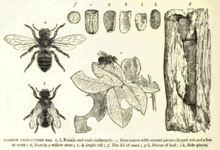
- Nests are typically divided into cells, each cell receives a supply of food (pollen or a pollen/nectar mix) and an egg; after finding a suitable spot (often near where she emerged), a female starts building a first cell, stocks it, and oviposits.
- Then she builds a wall that separates the completed cell from the next one.
- The larva hatches from the egg and consumes the food supply. After moulting a few times, it spins a cocoon and pupates.
- Then it emerges from the nest as an adult. Males die shortly after mating, but females survive for another few weeks, during which they build new nests.
Variations:
- Nests are often (but not always) built in natural or artificial cavities. Some embed individual cells in a mass of clay or resin attached to a wall, rock surface, or plant stem.
- Nest cavities are often linear, for example in hollow plant stems, but not always (snail shells are used by some Osmia, and some species will readily use irregular cavities).
Parasitic species
Some genera of Megachilids are brood parasites and, therefore, have no ventral scopa (e.g. Stelis and Coelioxys). They often parasitize related taxa. They typically enter the nest before it is sealed and lay their eggs in a cell. After hatching, the parasite larva kills the host larva, unless the female parasite has already done so, and then consumes the provisions. Parasitic species are of equal size or smaller than their victims.
Systematics
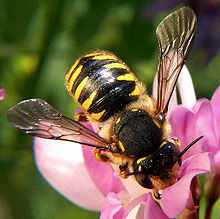
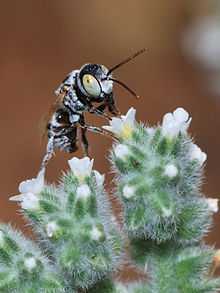

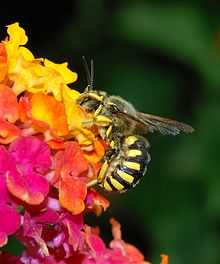
- Subfamily Fideliinae
- Tribe Pararhophitini
- Pararhophites
- Tribe Fideliini
- Fidelia
- Neofidelia
- Tribe Pararhophitini
- Subfamily Megachilinae
- Tribe Lithurgini
- Lithurgus
- Microthurge
- Trichothurgus
- Tribe Osmiini
- Afroheriades
- Ashmeadiella
- Atoposmia
- Bekilia
- Chelostoma
- Haetosmia
- Heriades are mason bees with narrow abdominal bands. They resemble small Osmia, but they are oligolectic (specialized on a few subfamilies of Asteraceae) and use resin from conifers, as well as plant fibers and sand, as cell wall material.
- Hofferia
- Hoplitis
- Hoplosmia
- Noteriades
- Ochreriades
- Osmia
- Othinosmia
- Protosmia
- Pseudoheriades
- Stenoheriades
- Stenosmia
- Wainia
- Xeroheriades
- Tribe Anthidiini
- Acedanthidium
- Afranthidium
- Afrostelis
- Anthidiellum
- Anthidioma
- Anthidium
- Anthodioctes
- Apianthidium
- Aspidosmia
- Austrostelis
- Aztecanthidium
- Bathanthidium
- Benanthis
- Cyphanthidium
- Dianthidium
- Duckeanthidium
- Eoanthidium
- Epanthidium
- Euaspis
- Gnathanthidium
- Hoplostelis
- Hypanthidioides
- Hypanthidium
- Icteranthidium
- Indanthidium
- Larinostelis
- Neanthidium
- Notanthidium
- Pachyanthidium
- Paranthidium
- Plesianthidium
- Pseudoanthidium
- Rhodanthidium
- Serapista
- Stelis Panzer and related genera (stelidine bees) are cleptoparasites on other Megachilidae. They belong to the tribe Anthidiini. Subgenus Heterostelis is parasitic on Trachusa.
- Trachusa
- Trachusoides
- Xenostelis
- Tribe Dioxyini
- Tribe Megachilini
- Incertae Sedis
- Neochalicodoma
- Stellenigris
- Tribe Lithurgini
External links
| Wikimedia Commons has media related to Megachilidae. |
- Palaearctic Osmiine Bees
- leafcutting bees on the UF / IFAS Featured Creatures Web site
- Online Guides to all the eastern North American Megachilidae
- Bugguide. Information and photos of Mechalidae of North America
| |||||||||||||||||||||||||||||||||||||||||||||||||||||||||||||||||||||||||||||||||||
